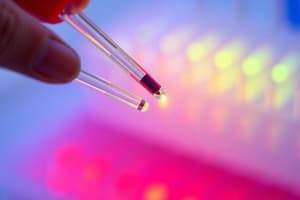Podcast
Questions and Answers
What is the primary purpose of denaturation in PCR, and at what temperature does it occur?
What is the primary purpose of denaturation in PCR, and at what temperature does it occur?
The primary purpose of denaturation is to separate the double-stranded DNA into single-stranded DNA, and it occurs at 95°C.
What is the ideal GC content range for PCR primers, and why is it important?
What is the ideal GC content range for PCR primers, and why is it important?
The ideal GC content range for PCR primers is between 40-60%, and it is important to ensure efficient and specific binding of the primers to the target DNA sequence.
What is the significance of the 3' end of a PCR primer, and how should it be designed?
What is the significance of the 3' end of a PCR primer, and how should it be designed?
The 3' end of a PCR primer should be designed to end in C or G to promote binding, and the last 5 bases should contain at least 2 Cs or 2 Gs.
Why is it important for PCR primers to have similar Tm values, and what is the maximum allowed difference?
Why is it important for PCR primers to have similar Tm values, and what is the maximum allowed difference?
What is the orientation of PCR primers, and why is it important?
What is the orientation of PCR primers, and why is it important?
Flashcards
Denaturation in PCR
Denaturation in PCR
Separates double-stranded DNA into single strands.
Ideal GC content for PCR primers
Ideal GC content for PCR primers
Ensures efficient and specific binding to the target DNA.
Significance of the 3' end of PCR primer
Significance of the 3' end of PCR primer
Promotes strong binding to the DNA template.
Similar Tm values for PCR primers
Similar Tm values for PCR primers
Signup and view all the flashcards
Orientation of PCR primers
Orientation of PCR primers
Signup and view all the flashcards
Study Notes
Polymerase Chain Reaction (PCR)
- PCR involves three main steps: Denaturation, Annealing, and Extension
- Denaturation: heating to 95°C to separate DNA strands
- Annealing: cooling to 55°C to allow primers to bind to target DNA
- Extension: heating to 72°C to synthesize new DNA strands
Primer Design Rules
- Primer orientation is always 5’-3’
- Primer length should be between 18-25 nucleotides (nt)
- GC content should be between 40-60% for efficient binding
- The 3’ end of the primer should end in C or G to promote binding
- The last 5 bases from the 3’ end should contain at least 2 Cs or 2 Gs
- Primers should have similar Tm (melting temperature) with a maximum difference of 5°C
- Primers should not be complementary to each other
Studying That Suits You
Use AI to generate personalized quizzes and flashcards to suit your learning preferences.




